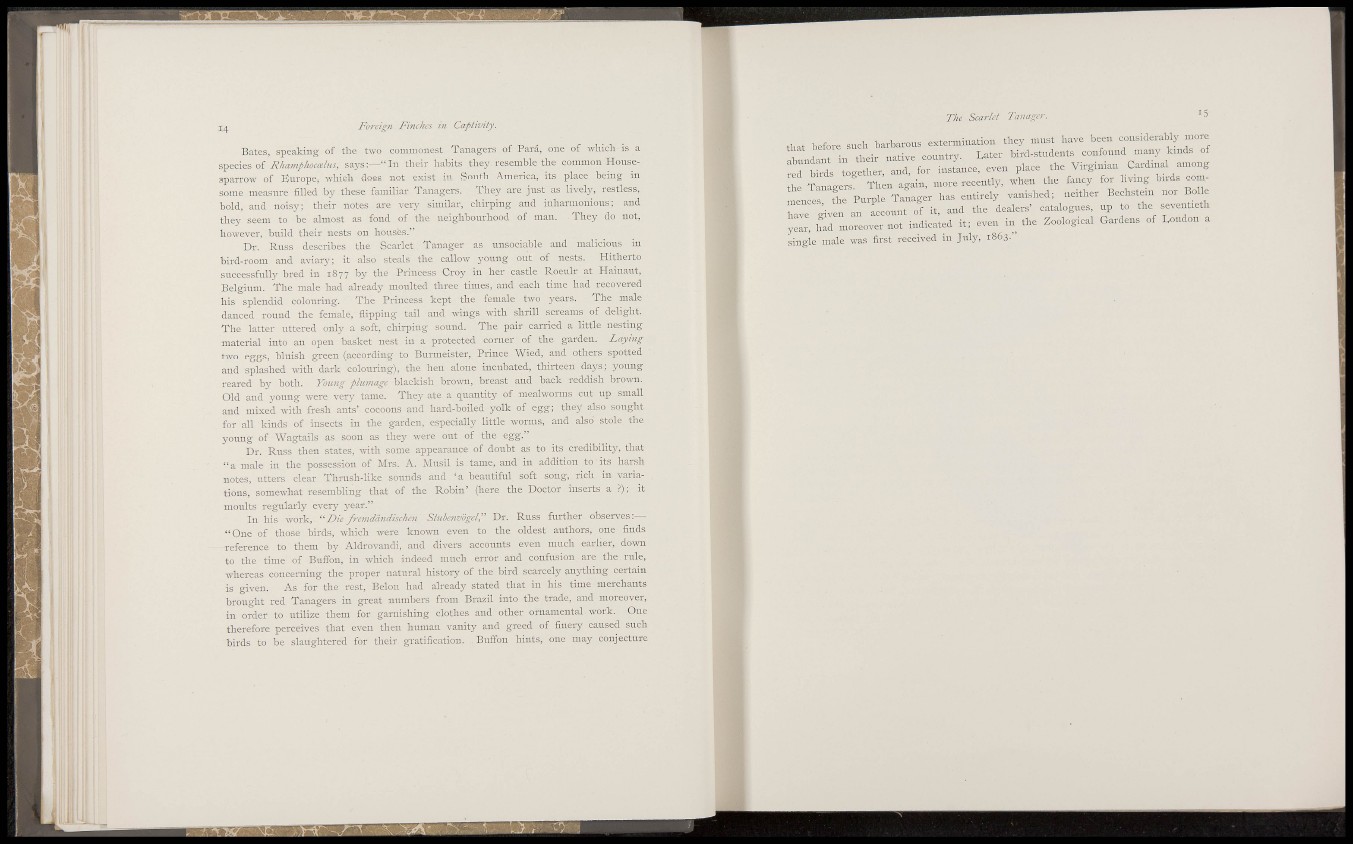
Foreign Finchcs in Captivity.
Bates, speaking of tlie two commonest Tanagers of Para, one of wliicli is a
species of Rhaviphocmliis, says:—"In tlieir habits they resemble the common Housesparrow
of Europe, which does not exist in South America, its place being in
sonie measure filled by these familiar Tauagers. They are just as lively, restless,
bold, and noisy; their notes are very similar, chirping and inharmonious; and
they seem to be almost as fond of the neighbourhood of man. They do not,
however, build their nests on houses."
Dr. Russ describes the Scarlet Tanager as unsociable and malicious in
bird-room and aviary; it also steals the callow young out of nests. Hitherto
successfully bred in 1877 by the Princess Croy in her castle Roeulr at Hainaut,
Belgium. The male had already moirlted three times, and each time had recovered
his "^splendid colouring. The Princess kept the female two years. The male
danced round the female, flipping tail and wings with shrill screams of delight.
The latter uttered only a soft, chirping sound. The pair carried a little nesting
material into an open basket nest in a protected corner of the garden. Laying
two eggs, bluish green (according to Burmeister, Prince Wied, and others spotted
aud splashed with dark colouring), the hen alone incubated, thirteen days; young
reared by both. Yowig plumage blackish browoi, breast and back reddish brown.
Old and young were verj^ tame. They ate a quantity of mealworms cut up small
and mixed with fresh ants' cocoons and hard-boiled yolk of egg; they also sought
for all kinds of insects in the garden, especially little worms, and also stole the
young of Wagtails as soon as they were out of the egg."
Dr. Russ then states, with some appearance of doubt as to its credibility, that
" a male in the possession of Mrs. A. Musil is tame, and in addition to its harsh
notes, utters clear Thrush-like soimds and 'a beautiful soft song, rich in variations,
somewhat resembling that of the Robin' (here the Doctor inserts a ?); it
moults regirlarly every year."
In his w^ork, "Die frcmdimdischen Stubenvogcl," Dr. Russ further observes:—
"One of those birds, which were known even to the oldest authors, one finds
reference to them by Aldrovandi, and divers accounts even much earlier, dovra
to the time of Buffon, in which indeed much error and confusion are the rule,
whereas concerning the proper natural history of the bird scarcely anything certain
is given. A.S for the rest, Belon had already stated that in his time merchants
brought red Tanagers in great numbers from Brazil into the trade, and moreover,
in order to utilize them for garnishing clothes and other ornamental work. One
therefore perceives that even then human vanity and greed of finery caused such
birds to be slaughtered for their gratification. Buffon hints, one may conjecture
I
The Scarlet Tanager. 15
that before such barbarous exterminatron they must have been considerably more
aildar^^ n their native country. Later bird-students confound many knrds of
r i ds together, and, for instance, even place the Virginian Cardinal among
£ Tanagers Then again, more recently, when the fancy for living birds come
n c é the Pui-ple Tanager has entirely vanished; neither Beclistein nor Bol^
T v e given an Account of it, and the dealers' catalogues up to the seventieth
year, had moreover not indicated it; even in the Zoological Gardens of London a
sino-le male was first received in July, 1863."